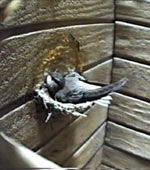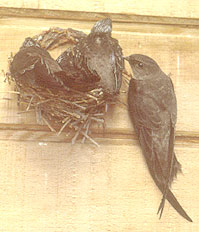 What’s in my chimney?
What’s in my chimney?
The chittering in your chimney may actually be birds and not bats. Chimney Swifts are migratory birds that return to Maryland in early April from as far away as South America. Like bats, these birds once nested in old hollow trees and now nest almost exclusively in chimneys because old trees have been removed from the landscape. And, like bats, they eat lots of flying insects.
The way you tell if you have birds or bats is by going outside at dusk and watching whether something comes out of your chimney or goes in. Bats are just getting ready to exit the chimney to forage for insects at dusk. Chimney Swifts look a lot like flying cigars and will fly into the chimney to roost for the night. These fantastic fliers do almost everything on the wing—eat, drink, break off twigs for their nests and are even thought to copulate in flight.

Chimney Swifts have specially designed feet that enable them to cling to vertical surfaces and sticky saliva that they use to hold their twig nests together.
Nest building takes place anywhere from 18 to 30 days but egg laying may begin before the nest is complete. Extreme egg dates are May 9 and August 12. Incubation lasts from 19 to 21 days.
Chittering you hear in the chimney from inside the house is made by baby swifts begging for food from their parents. Baby swifts take their first flight about 30 days from hatching and make the loudest noises during the last two weeks in the nest. By the time most homeowners hear the chittering, the babies often will be ready to leave the chimney within two weeks.
The Swift Solution
Chimneys that are made of stone, firebrick or masonry flue tiles with mortared joints provide the right surfaces for nesting Chimney Swifts. Metal chimneys are unsuitable for nesting and should always be capped to prevent trapping swifts and other animals inadvertently.
Unlike creosote buildup, swift nests in chimneys do not cause problems for the homeowner. Chimneys should be cleaned in mid-March or after the wood-burning season ends and before the swifts come back from South America in April. Dampers should be inspected and remain closed during the nesting season to prevent birds from flying in the house and becoming trapped or injured. In instances where older houses don’t have dampers or the dampers may not work, the homeowner can wedge a large piece of foam rubber to serve as a damper until the swifts have finished nesting.
If birds are found in the fireplace below the damper, those which are fully-feathered with eyes wide open should be placed on the wall above the damper and allowed to climb back up into the chimney. If younger or injured birds are found below the damper, licensed wildlife rehabilitators should be contacted. Reschedule any cleaning for a later date: at least 6 weeks for chimneys with eggs, and at least 4 weeks for chimneys with young. The best time is late fall after the swifts have migrated south for the winter.
If you cannot wait until the babies have fledged you may contact a licensed wildlife cooperator to help you find a solution. Chimney Swifts are protected by the Migratory Bird Treaty Act and a federal permit is needed to remove birds and their nests during the nesting season.
Prior to migration, Chimney Swifts will stage at particular chimneys before flying south for the winter. Sometimes hundreds of birds will circle and roost in one chimney. In Maryland, this spectacle usually occurs in September and lasts only for a short period of time. If you discover that your chimney provides a temporary roost for staging, you may want to consider building a Chimney Swift tower to provide alternate housing for these marvelous birds.
Partners in Flight documents a 67% population decline in Chimney Swifts from 1970-2014. The Chimney Swift Conservation Program, through the Maryland Bird Conservation Partnership, seeks to assess local Chimney Swift populations as well as increase nesting areas for local birds. To help local Chimney Swifts, consider helping with the program through reporting active chimney/tower sites, providing homes for Chimney Swifts, and/or volunteering for the program. For more information, please visit: https://marylandbirds.org/chimney-swifts
Photographs courtesy of Driftwood Wildlife Association